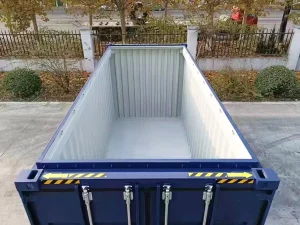-
12
Jan
Advantages and Disadvantages of Open Top Container – India
Air Chartering, air freight, Air Freight Forwarding, Cargo Insurance, custom clearance, Customs Clearance for Export / Import Shipments, Door to Door service, Freight Forwarders Chennai, Freight forwarders In India, Freight forwarders in Mumbai, Freight Forwarding, Freight Forwarding company in India, Freight forwarding company in Mumbai, Indian Freight forwarder, Inland Transportation, Logistics, Logistics Company in India, Logistics Service Provider in India, ocean freight, ODC Cargo, Over Dimensional Cargo, personal effects, Project cargo Handling, Sea Freight Forwarding, Warehousing & Distribution, Warehousing and distribution
Meaning
have an open top covered by a tarpaulin instead of a solid roof. This enables oversized cargo such as timber and scrap metal to be loaded from the top.
Open-top containers are a type of shipping container with an openable top, typically covered with a tarpaulin or removable roof bows and tarpaulin. This design allows for easy top loading and unloading of goods that might be difficult or oversized for standard containers. Here are some advantages and disadvantages of open-top containers:
Advantages:
- Easy Loading and Unloading:
- The open-top design allows for easy loading and unloading of cargo, especially when the goods are large, heavy, or have irregular shapes.
- Versatility:
- Ideal for transporting goods that exceed the height limitations of standard containers, such as machinery, industrial equipment, or tall items.
- Flexible Loading Options:
- Cargo can be loaded from the top using cranes, gantry systems, or other specialized equipment, providing flexibility in handling various types of cargo.
- Efficient for Overhead Loading:
- Suitable for goods that need to be loaded or unloaded from the top using overhead cranes or similar equipment.
- Great for Bulky or Project Cargo:
- Well-suited for transporting oversized and project cargo that may not fit in standard containers due to their size or shape.
- Reduced Need for Disassembly:
- For certain types of machinery or equipment, open-top containers eliminate the need for disassembly, making the loading and unloading process more efficient.
Disadvantages:
- Exposure to Weather:
- Cargo in open-top containers is exposed to the weather elements, including rain and sunlight. This can be a disadvantage for goods sensitive to weather conditions.
- Security Concerns:
- The open-top design may pose security challenges, as the cargo is more accessible and exposed to potential theft or tampering compared to standard closed containers.
- Limited Stackability:
- Open-top containers are often less stackable than standard containers due to their design, which may impact the efficiency of container ships and storage yards.
- Additional Handling:
- The need for removing and securing the tarpaulin or roof bows adds an extra step in the loading and unloading process, which can be time-consuming.
- Higher Maintenance:
- The tarpaulin or removable roof requires maintenance, and exposure to weather conditions may lead to wear and tear over time.
- Limited Temperature Control:
- Open-top containers do not provide insulation or temperature control, making them unsuitable for goods that require a controlled environment.
The choice between open-top and standard containers depends on the specific requirements of the cargo being transported. Open-top containers are particularly beneficial for certain types of oversized or project cargo, but considerations should be made regarding the nature of the goods and the potential impact of weather exposure.

B-214/215 A /222, ASHOKA SUPER MARKET,
S.V ROAD, GOREGAON WEST,
MUMBAI 400062
INDIA
CTC :- BALA IYER – +919820517857 ( PHONE / WHATSAPP)
SACHIN TIWARI – +917700914388 ( PHONE/ WHATSAPP)
Comments are closed.
- Easy Loading and Unloading:
Advantages and Disadvantages of Open Top Container – India

B-214/215 A /222, ASHOKA SUPER MARKET,
S.V ROAD, GOREGAON WEST,
MUMBAI 400062
INDIA
CTC :- BALA IYER – +919820517857 ( PHONE / WHATSAPP)
SACHIN TIWARI – +917700914388 ( PHONE/ WHATSAPP)




